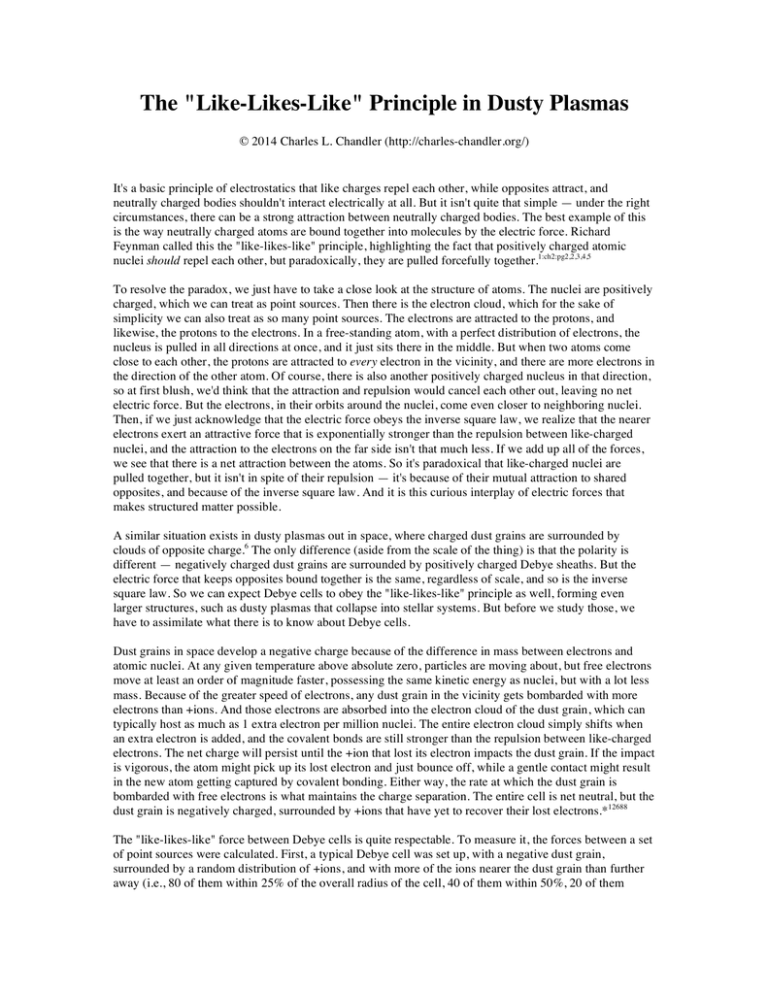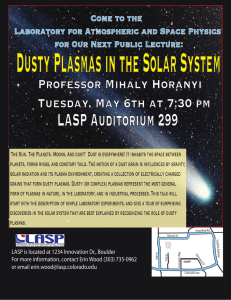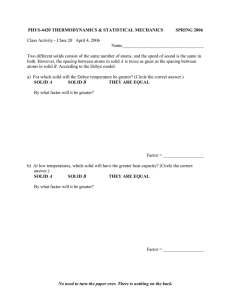"Like-Likes-Like" Principle in Dusty Plasmas
advertisement

The "Like-Likes-Like" Principle in Dusty Plasmas © 2014 Charles L. Chandler (http://charles-chandler.org/) It's a basic principle of electrostatics that like charges repel each other, while opposites attract, and neutrally charged bodies shouldn't interact electrically at all. But it isn't quite that simple — under the right circumstances, there can be a strong attraction between neutrally charged bodies. The best example of this is the way neutrally charged atoms are bound together into molecules by the electric force. Richard Feynman called this the "like-likes-like" principle, highlighting the fact that positively charged atomic nuclei should repel each other, but paradoxically, they are pulled forcefully together.1:ch2:pg2,2,3,4,5 To resolve the paradox, we just have to take a close look at the structure of atoms. The nuclei are positively charged, which we can treat as point sources. Then there is the electron cloud, which for the sake of simplicity we can also treat as so many point sources. The electrons are attracted to the protons, and likewise, the protons to the electrons. In a free-standing atom, with a perfect distribution of electrons, the nucleus is pulled in all directions at once, and it just sits there in the middle. But when two atoms come close to each other, the protons are attracted to every electron in the vicinity, and there are more electrons in the direction of the other atom. Of course, there is also another positively charged nucleus in that direction, so at first blush, we'd think that the attraction and repulsion would cancel each other out, leaving no net electric force. But the electrons, in their orbits around the nuclei, come even closer to neighboring nuclei. Then, if we just acknowledge that the electric force obeys the inverse square law, we realize that the nearer electrons exert an attractive force that is exponentially stronger than the repulsion between like-charged nuclei, and the attraction to the electrons on the far side isn't that much less. If we add up all of the forces, we see that there is a net attraction between the atoms. So it's paradoxical that like-charged nuclei are pulled together, but it isn't in spite of their repulsion — it's because of their mutual attraction to shared opposites, and because of the inverse square law. And it is this curious interplay of electric forces that makes structured matter possible. A similar situation exists in dusty plasmas out in space, where charged dust grains are surrounded by clouds of opposite charge.6 The only difference (aside from the scale of the thing) is that the polarity is different — negatively charged dust grains are surrounded by positively charged Debye sheaths. But the electric force that keeps opposites bound together is the same, regardless of scale, and so is the inverse square law. So we can expect Debye cells to obey the "like-likes-like" principle as well, forming even larger structures, such as dusty plasmas that collapse into stellar systems. But before we study those, we have to assimilate what there is to know about Debye cells. Dust grains in space develop a negative charge because of the difference in mass between electrons and atomic nuclei. At any given temperature above absolute zero, particles are moving about, but free electrons move at least an order of magnitude faster, possessing the same kinetic energy as nuclei, but with a lot less mass. Because of the greater speed of electrons, any dust grain in the vicinity gets bombarded with more electrons than +ions. And those electrons are absorbed into the electron cloud of the dust grain, which can typically host as much as 1 extra electron per million nuclei. The entire electron cloud simply shifts when an extra electron is added, and the covalent bonds are still stronger than the repulsion between like-charged electrons. The net charge will persist until the +ion that lost its electron impacts the dust grain. If the impact is vigorous, the atom might pick up its lost electron and just bounce off, while a gentle contact might result in the new atom getting captured by covalent bonding. Either way, the rate at which the dust grain is bombarded with free electrons is what maintains the charge separation. The entire cell is net neutral, but the dust grain is negatively charged, surrounded by +ions that have yet to recover their lost electrons.*12688 The "like-likes-like" force between Debye cells is quite respectable. To measure it, the forces between a set of point sources were calculated. First, a typical Debye cell was set up, with a negative dust grain, surrounded by a random distribution of +ions, and with more of the ions nearer the dust grain than further away (i.e., 80 of them within 25% of the overall radius of the cell, 40 of them within 50%, 20 of them within 75%, and another 10 around the outside). That made a total of 150 +ions, so the corresponding charge on the dust grain was set to -150 e. The radius of the entire cell was arbitrarily set to 1 m. Figure 1. Particles in a Debye cell, where the nucleus is red, and the randomly distributed +ions are blue. To estimate the mass distribution so that the force of gravity could be calculated, it could not be assumed that a Debye cell has only elementary charges (protons and electrons), since such a complete charge separation would be quite impossible. It was mentioned earlier that a dust grain can host as much as 1 extra electron per million atoms, but that's a high-end number. A far more conservative estimate would be 1 ion per 1016 neutral atoms. So the 150 +ions were each assigned a charge of +e, and the mass of a proton times 1016. The dust grain in the center was assigned a charge of -150 e, and a mass of 150 protons times 1016. This produced a realistic mass and charge distribution within the cell. Then, a 3D array of 57 Debye cells was created, in a closest packed arrangement, so that the forces between the particles in each cell could be calculated. HCP closest packed arrangement of 57 spherical Debye cells. Figure 2. Top view. Figure 3. Perspective view. Figure 4. Section view. Red is negative; blue is positive. Then the gravitational and electric forces between the nucleus of the Debye cell at the center, and all of the particles in the other 56 Debye cells (i.e., 1 nucleus and 150 ions per cell), were summed. Gravity Electricity F = Gm1m2/r2 F = Eq1q2/r2 where: where: F F = force (newtons) = force (newtons) G = Gravitational Constant E = electric constant m1 = mass of first object (kg) q1 = first charge (coulombs) m2 = mass of second object (kg) q2 = second charge (coulombs) r r = distance between centers (m) = distance between centers (m) It was found that the omnidirectional force (i.e., the body force) on the test charge in the center varied significantly with the spacing between the Debye cells. Figure 5 shows the ratio between the electric and gravitational forces (on the Y axis) at different spacings (on the X axis). The solid line shows that the electric force was roughly 5 times greater than gravity if the Debye cells were 10 m apart (center-to-center). Nearer, e/g asymptotically approached a peak of 1282 at 50 cm (way off-scale in Figure 5). From there, the electric force went from extremely attractive to extremely repulsive, with e/g coming back into view (e/g = 100) at 35 cm, dropping to -20 at 34 cm, and continuing off-scale at that near-vertical slope. Figure 5. Ratio of electric and gravitational forces between Debye cells, per the center-to-center spacing. The solid line is for 1 charged particle in 1016. The dashed line is for 5 charged particles in 1015. Since the outside radius of each Debye cell was 1 m, it's no surprise that the electric attraction reached a peak with the cells separated by a little less than 1 m. That's when most of the shared charge was between the cell nuclei. And since the electric force is so much stronger than gravity, its exponential increase produced a sharp increase in the e/g ratio. But when the cells were too close together, the mutual attraction to shared +ions was gone, and the repulsion of like charges took over. The effect was dramatic because at such a close range, the E-field was very dense. Figure 6. Maximum attraction at .5 m. Figure 7. Strong repulsion at < .3 m. The forces also varied considerably if the net charge was changed. The dashed line in Figure 5 shows the e/g values for 5 ions per 1015 atoms. Still at a center-to-center spacing of 10 meters, the electric force was roughly 20 times that of gravity, and it asymptotically approached a much higher peak at .5 m. The implications for the study of dusty plasmas are numerous. First we should note that the e/g curve is very different from the forces acknowledged in the Jeans Instability. With only gravity and hydrostatic pressure taken into account, a collapsing dusty plasma will see an increase in the density of the gravity field, but also an increase in the pressure. Since the pressure varies inversely with the volume, and directly with the temperature (which goes up in the thermalization of particle collisions), the pressure increases faster than the gravity, and somewhere in there, a hydrostatic equilibrium will be achieved, where the force of gravity is offset by the gas pressure. Thus in Newtonian mechanics, and all astronomical heuristics notwithstanding, there isn't any threshold for gravitational collapse. There is no theoretical limit to the density of a gravity field, but neither is there one for gas pressure, and the latter increases faster than the former, setting an equilibrium point, which is the opposite from a threshold for an instability. This begs the question of what overpowers hydrostatics, and rams the plasma together violently enough to fuse it into a star. Clearly, another force is present. And we know that dusty plasmas are ionized — that's why we call them plasmas. Even an extremely weak ionization (1:1016) produces more force than gravity, and the force increases exponentially with proximity, peaking at over 1282 times the force of gravity. This gives the collapsing plasma the momentum necessary to overshoot the hydrostatic equilibrium and pack the matter into a star. Second, dusty plasmas are famous for collapsing after there has been a nearby supernova. This is inexplicable in terms of the Jeans Instability. To cause a collapse with Newtonian forces, the supernova would have to increase the gravity and/or decrease the pressure in the gas cloud. Absorbing particulate ejecta from a supernova will certainly increase the gravity, but the thermalization of the relativistic velocities of those particles will greatly increase the temperature, and therefore the pressure. So rather than lowering the hydrostatic equilibrium, it should raise it, causing the expansion of the gas cloud. But supernovae are also famous for emitting a large volume of UV radiation, which photo-ionizes matter in the vicinity.6:79 If the ionization goes from 1:1016 to 5:1015, the "like-likes-like" force in a set of Debye cells 10 m apart gets quadrupled. So supernovae cause the collapse of dusty plasmas, in spite of the insignificant increase in gravity, and regardless of the increase in temperature, because of the increase in the electric force. References 1. Feynman, R.; Leighton, R.; Sands, M., 1970: The Feynman Lectures on Physics. Reading, MA, USA: Addison-Wesley 2. Nagornyak, E.; Pollack, G. H., 2005: Connecting filament mechanics in the relaxed sarcomere. Journal of Muscle Research and Cell Motility, 26 (6-8): 303-306 3. Pollack, G. H.; Figueroa, X.; Zhao, Q., 2009: Molecules, Water, and Radiant Energy: New Clues for the Origin of Life. International Journal of Molecular Sciences, 10 (4): 1419 4. Zhao, Q.; Coult, J.; Pollack, G. H., 2010: Long-range attraction in aqueous colloidal suspensions. Proceedings of the Society of Photo-Optical Instrumentation, 7376: 73761C1-73761C13 5. Pollack, G., 2013: The Fourth Phase of Water: Beyond Solid, Liquid, and Vapor. Seattle: Ebner and Sons Publishers 6. Merlino, R. L., 2006: Dusty Plasmas and Applications in Industry and Space. Pgs 73-110 in "Plasma Physics Applied." Kerala, India: Transworld Research Network


